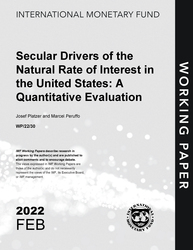
Secular Drivers of the Natural Rate of Interest in the United States: A Quantitative Evaluation
Secular Drivers of the Natural Rate of Interest in the United States: A Quantitative Evaluation
READ MORE...
Volume/Issue:
Volume 2022
Issue 030
Publication date: February 2022
ISBN: 9798400200519
$5.00
Add to Cart by clicking price of the language and format you'd like to purchase
Available Languages and Formats
| English |
Prices in red indicate formats that are not yet available but are forthcoming.
Topics covered in this book
This title contains information about the following subjects.
Click on a subject if you would like to see other titles with the same subjects.
Banks and Banking , Economics- Macroeconomics , Public Finance , Economics / General , Demography , Demographic Change , Inequality , Life-cycle , Natural Rate of Interest , Nonhomothetic Preferences , Secular Stagnation , transition path , baseline transition-path , labor income , uninsurable income risk , implied path , path of r , Nonhomothetic consumption preference , Income inequality , Income , Productivity , Consumption , Europe , Global
Summary
We develop a heterogeneous agent, overlapping generations model with nonhomothetic preferences that nests several explanations for the decline in the natural rate of interest (r∗) suggested in the literature: demographic change, a slowdown in productivity growth, a rise in income inequality, and public policy. The model can account for a 2.2 percentage point (pp) decline in r∗ between 1975 and 2015, which is within the range of empirical estimates. Rising income inequality is an important driver (-0.70 pp), and together with demographic change (-0.71 pp) and the slowdown in productivity growth (-1.0 pp) explains most of the decline. Growing public debt is the major counteracting force (+0.31 pp). Permanent income inequality is of greater importance than inequality due to uninsurable income risk, and matching the degree of nonhomotheticity in consumption and savings behavior to empirical estimates is essential for this result. We predict that r∗ will reach a low of 0.38% by 2030, after which a slow reversal will begin. The natural rate will stabilize at 1% in the long run, a low level when compared with the postwar path of r∗ implied by the model. This remains true even if we take into account soaring public debt levels due to the COVID-19 pandemic. Policy can have considerable impact on the level of r∗ through the tax and transfer system.
Copyright © 2010 - 2025
Powered by:
AIDC



